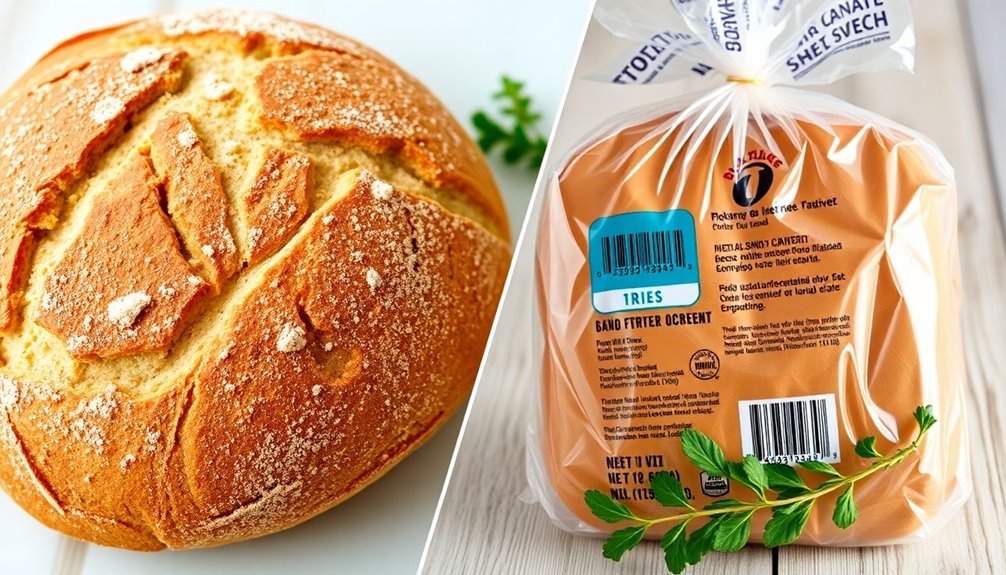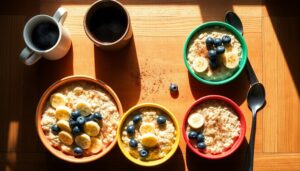When it comes to homemade bread versus store-bought, homemade is healthier and more cost-effective. You can control the ingredients, ensuring a nutritious loaf without added sugars or preservatives. It typically costs between $0.40 and $1.00 per loaf, while organic store-bought can hit $3 or more. Plus, with whole grains and seeds, you'll get higher fiber and essential nutrients. Baking at home also fosters mindfulness and reduces packaging waste. Overall, you'll enjoy better health and savings in the long run. Keep exploring to discover more about the benefits of homemade bread!
Health Benefits of Homemade Bread
When you whip up a batch of homemade bread, you're not just creating a warm, delicious treat; you're also reaping significant health benefits. By opting for whole grain flours, you boost the fiber content and essential nutrients in your diet, which supports digestive health. Regularly making your own bread can help you track your spending, as ingredient costs are often lower than purchasing high-quality commercial bread.
Additionally, engaging in conscious consumerism when baking encourages you to choose better quality ingredients that benefit both your health and the environment.
Unlike many store-bought options, homemade bread made with whole grains delivers more vitamins and minerals per serving, prioritizing quality over shelf stability.
Another vital advantage is your control over ingredients. You can easily avoid added sugars and unhealthy fats that often sneak into commercial varieties, helping you reduce the risk of weight gain and chronic diseases.
This mindfulness in baking promotes a deeper appreciation for food, encouraging healthier eating habits overall.
Moreover, without artificial additives or preservatives, your homemade bread is gentler on your digestive system, minimizing issues linked to processed ingredients.
The combination of these factors makes homemade bread a standout choice for those seeking both deliciousness and nutrition. Additionally, making your own bread can be a cost-effective alternative to buying commercial options, allowing you to save money while enjoying healthier ingredients.
Cost-Effectiveness of Homemade Options
When you make homemade bread, you can save considerably by buying ingredients in bulk, which lowers your overall costs. Plus, freezing extra loaves lets you enjoy fresh bread for months without wasting any. Additionally, using budgeting apps can help track your spending on ingredients, ensuring you stay within your financial goals. Utilizing tools like YNAB's zero-based budgeting can further enhance your financial planning by helping you assign a job to every dollar spent on baking supplies. Furthermore, adopting disciplined savings habits can lead to even greater long-term financial stability. Over time, these savings can really add up compared to regularly purchasing store-bought options.
Bulk Ingredient Savings
Making homemade bread offers considerable savings, especially when you purchase ingredients in bulk. By doing so, you can greatly reduce the cost per loaf compared to buying organic store-bought bread, which can be quite pricey.
Here are some key points to reflect on about bulk ingredient savings:
- Cost per loaf: Homemade bread typically costs between $0.40 to $1.00, while organic options can set you back $3 to $6 or more.
- Ingredient savings: Buying flour and yeast in larger quantities lowers your cost per unit, maximizing value.
- Batch baking: Making multiple loaves at once means you can stretch those bulk ingredients even further, cutting costs for each loaf.
- Minimized waste: Freezing leftover bread helps you avoid waste, ensuring you get the most out of your initial purchase.
- Recipe customization: You can use more affordable ingredients, like whole wheat flour instead of premium grains, enhancing the cost-effectiveness of your homemade bread.
Freezing and Storage Benefits
Homemade bread's freezing and storage benefits can greatly enhance its cost-effectiveness. By freezing homemade bread, you can store it for up to three months, which helps reduce waste and allows you to bake in bulk. This means you can prepare multiple loaves at once, maximizing your savings.
Slicing bread before freezing makes it easy to grab just what you need, minimizing defrosting time and ensuring freshness every time you use it. To keep your bread in top shape, wrap it tightly in plastic wrap or aluminum foil to prevent freezer burn. This way, you maintain the quality and taste until you're ready to enjoy it.
Additionally, if you choose to store your bread in a bread box or wrapped in a kitchen towel, it absorbs excess moisture and helps retain freshness without relying on preservatives.
When you consider that the cost per loaf of homemade bread can be as low as $0.40 to $1.00, it's clear that this option is markedly cheaper than many store-bought options.
Long-Term Cost Comparison
In the long run, choosing to bake your own bread can lead to significant savings compared to buying store-bought options. Homemade bread typically costs between $0.40 and $1.00 per loaf, while organic bakery bread can be much pricier.
By baking in batches and freezing extras, you can save money and reduce waste, as store-bought bread often spoils before you finish it. Plus, you can customize recipes to meet your dietary needs without the added expense of specialty products.
Consider these cost-effective benefits of homemade bread:
- Control over ingredient quality, avoiding preservatives and additives
- Ability to bake multiple loaves at once, minimizing waste
- Savings on grocery bills by choosing simple, affordable ingredients
- Flexibility to adjust recipes for personal preferences
- Initial investment in baking tools pays off over time
Ingredient Control in Homemade Bread
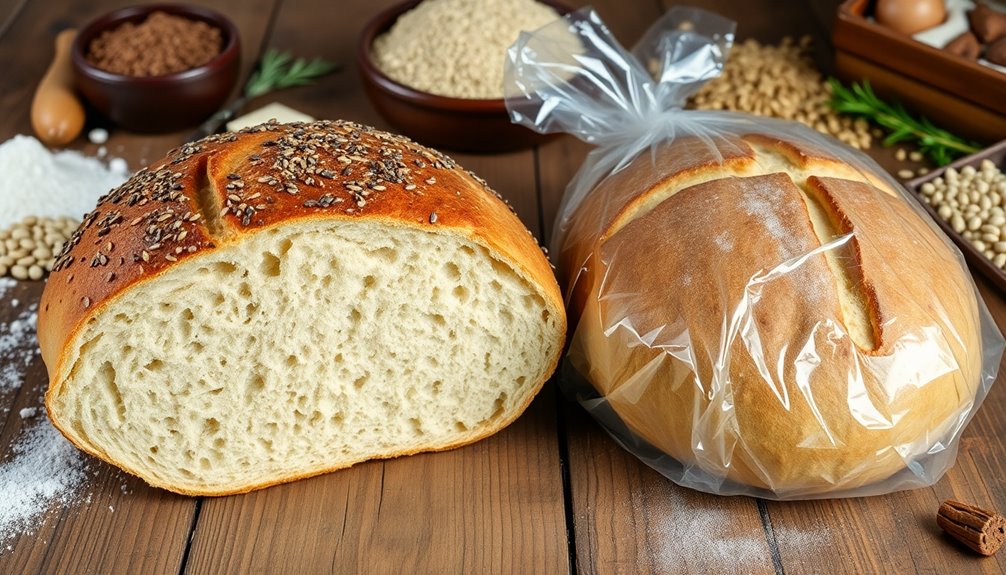
When you bake bread at home, you gain complete control over the ingredients, ensuring that every slice aligns with your health goals and preferences. You can choose high-quality whole wheat flour, organic options, or even gluten-free alternatives. This level of ingredient control means you can avoid harmful additives and preservatives often found in store-bought bread, like high fructose corn syrup and hydrogenated oils. Additionally, using homemade bread can help you save on cost-effective solutions that are beneficial for entrepreneurs, especially when you consider the potential for streamlined bookkeeping processes to manage your expenses.
Homemade bread recipes are typically simple, requiring just four basic ingredients: flour, water, yeast, and salt. You can easily customize these recipes to fit your dietary needs, whether that means reducing sugar or excluding common allergens like nuts.
By opting for whole wheat or rye flour, you can enhance the nutritional value of your bread, packing it with more fiber and essential nutrients compared to many processed varieties.
Plus, making bread at home is often more cost-effective. The average cost of a homemade loaf ranges from $0.40 to $1.00, which is usually less than organic bakery options and allows you to produce multiple loaves at once. Additionally, by baking at home, you can also implement sustainable delivery practices by reducing the need for trips to the store.
Enjoy the satisfaction of knowing exactly what goes into your bread!
Nutritional Comparison: Homemade vs. Store-Bought
Choosing to bake bread at home not only gives you control over ingredients but also considerably impacts its nutritional profile. When you make your own bread, you can guarantee that every slice is packed with essential nutrients, setting it apart from many store-bought breads.
Here's how homemade bread typically outshines its commercial counterparts:
- Fewer calories per slice, especially when crafted with whole grains.
- Higher nutritional value, providing more fiber and protein.
- No additives or preservatives, resulting in cleaner ingredient lists.
- Lower glycemic index, promoting better blood sugar management.
- Customization of sugar content, eliminating hidden sugars.
Store-bought breads often fall short in these areas, frequently containing high-fructose corn syrup and hydrogenated oils. Many of these additives and preservatives can compromise not just flavor but also your health. By opting for homemade versions, you maximize the nutritional content by using fresh, whole ingredients that retain their bran and germ. Additionally, baking your own bread can foster financial literacy by allowing you to better understand the costs associated with different ingredients. Moreover, choosing to bake at home supports sustainable businesses that promote ethical sourcing of ingredients.
In short, when you bake your own bread, you're not just enjoying a delicious loaf; you're also making a healthier choice for your well-being.
Sugar Management in Bread Choices

Sugar plays a significant role in the bread you consume, influencing both taste and health. When you opt for store-bought bread, you might be unaware of the hidden sugars lurking in the ingredients, contributing to weight gain and other health risks.
In contrast, homemade bread gives you the power of sugar management. You can control the amount of sugar you add, allowing you to reduce or even eliminate it entirely. Furthermore, utilizing expense tracking apps can help you budget for high-quality ingredients, enhancing your homemade bread experience. Additionally, incorporating bill tracking apps can support your financial planning for consistent ingredient purchases.
By cutting down on sugar in your homemade bread recipes, you lower your risk of developing diabetes and heart disease. This makes homemade bread a healthier choice compared to most store-bought options. Additionally, using whole grain flours in your recipes not only enhances flavor but also increases fiber content, which helps regulate blood sugar levels and supports digestive health.
Understanding the glycemic index of different flours can further improve your sugar management in homemade bread. Choosing lower glycemic index options leads to more stable blood sugar levels, making your bread not just a delicious treat but also a smart health choice.
Embrace the benefits of homemade bread and take charge of your sugar intake!
Mindfulness in the Baking Process
Baking bread at home invites you to slow down and immerse yourself in the entire process, transforming it into a mindful experience. As you engage with each step, you foster a deeper connection to the wholesome ingredients you choose. The sensory richness of mixing, kneading, and watching the dough rise enhances your appreciation for food preparation.
- Feel the texture of the dough beneath your hands.
- Breathe in the comforting aromas as the bread bakes.
- Notice the rhythmic motions of kneading that can serve as a meditative practice.
- Observe the transformation of simple ingredients into something nourishing.
- Reflect on the time and effort involved, fostering gratitude for your food.
This mindfulness in baking promotes relaxation and reduces stress, allowing you to focus on the present moment. The act of creating your bread can evoke feelings of satisfaction and comfort, reinforcing a positive emotional connection to what you eat.
Freezing and Storing Homemade Bread
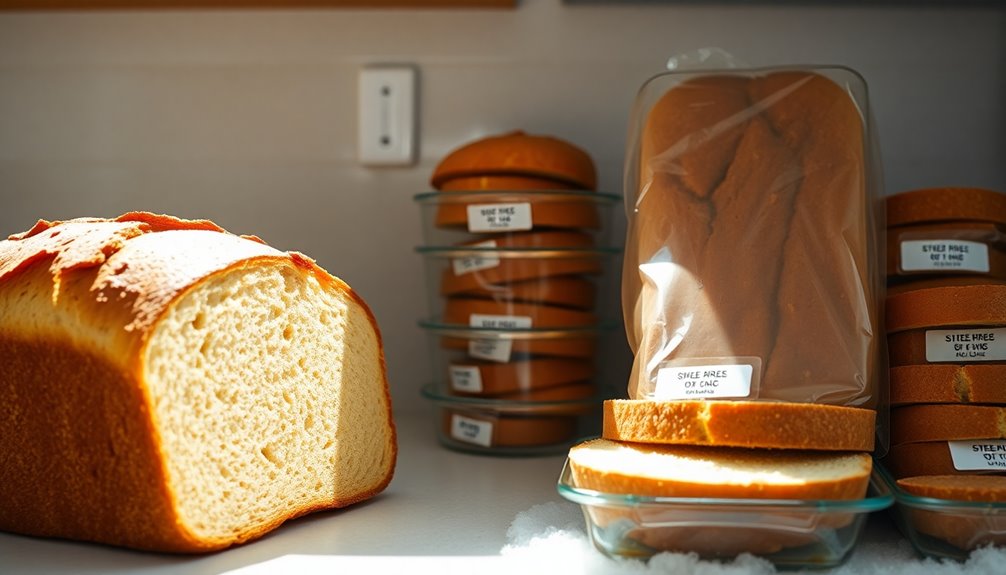
After enjoying the mindful experience of baking homemade bread, you'll want to guarantee it stays fresh for as long as possible. Freezing your homemade bread is a great way to extend its shelf life.
Start by slicing the bread before freezing, allowing for easy access to portions later. Wrap it tightly in plastic wrap or aluminum foil to prevent freezer burn, then store it in a freezer-safe bag or airtight container. Don't forget to label and date it—properly stored, your homemade bread can last up to three months in the freezer.
When you're ready to enjoy it again, thaw the bread by letting it sit at room temperature or pop it in the oven at 350°F (175°C) for 10-15 minutes to revive that fresh-baked taste.
For ideal storage, consider using a bread box to maintain humidity and air circulation. Alternatively, wrap the bread in a kitchen towel to absorb excess moisture. Avoid refrigeration, as it speeds up staling.
With proper storage, your homemade bread can retain its freshness and quality longer than store-bought varieties, which often contain preservatives for extended shelf life.
Essential Tools for Bread Making
When it comes to making bread at home, having the right tools can make all the difference. Investing in essential kitchen tools not only streamlines the process but also improves your results.
Here's a list of must-haves for your bread-making journey:
- Harvest grain mill: For grinding grains fresh for your bread dough.
- Classic grain mill: Versatile for milling different types of flour.
- High-quality Damascus bread knife: Guarantees precise slicing of your loaves.
- Mixing bowls: Opt for stainless steel or glass for durability and easy cleaning.
- Baking sheets: Vital for baking your loaves evenly.
Accurate measuring tools, including cups, spoons, and a kitchen scale, are essential for achieving the perfect ingredient proportions.
A Dutch oven is highly recommended for baking, as it retains heat and traps moisture, giving you that crusty exterior and soft interior you desire.
Additionally, a dough scraper and a proofing basket can enhance your bread-making experience by helping you shape the dough and guarantee proper fermentation.
With these tools, you'll be well on your way to crafting delicious homemade bread.
Simple Recipes to Get Started
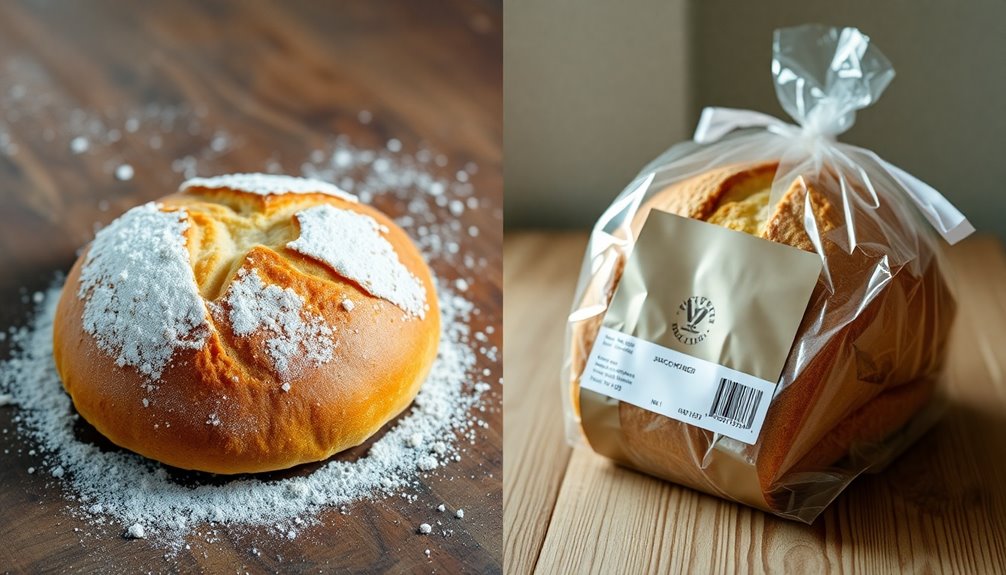
Getting started with homemade bread is easier than you might think, especially with simple recipes that require just a few basic ingredients. One of the best ways to plunge into it's by trying a no-knead bread recipe.
You'll only need 3 cups of all-purpose flour, 5 teaspoons of sea salt, 2 teaspoons of active dry yeast, and ½ cup of water. Mix these together, let the dough rest overnight, and then bake it in a Dutch oven for an effortless and delicious loaf.
This no-knead bread is perfect for beginners, as it minimizes effort while maximizing flavor. Plus, once you get comfortable, you can experiment by adding herbs, seeds, or whole grains to enhance nutritional value and cater to your taste preferences.
Don't hesitate to explore online resources and community forums for more beginner-friendly bread recipes and tips. These platforms can inspire you and help build your confidence in baking.
Customization for Dietary Needs
One of the biggest advantages of homemade bread is the ability to customize it for your specific dietary needs. You can control every ingredient, allowing you to exclude allergens like gluten or nuts, and even choose alternative flours such as almond or coconut. This level of customization can be particularly beneficial if you're concerned about weight gain or health issues.
Here are some ways you can tailor your homemade bread:
- Customizing sugar levels to cut down on hidden sugars found in store-bought bread.
- Adapting recipes for vegan, low-carb, or paleo diets to accommodate different eating habits.
- Using whole grain flours and adding seeds or nuts to boost fiber and nutrient density.
- Ensuring no preservatives or artificial ingredients make their way into your bread.
- Easily adjusting recipes to meet specific dietary restrictions without sacrificing flavor.
With the simplicity of homemade bread recipes, you can make modifications that fulfill your dietary requirements while still enjoying delicious bread.
This flexibility not only enhances your health but also makes it easier to share your creations with friends and family.
The Art of Sourdough Baking
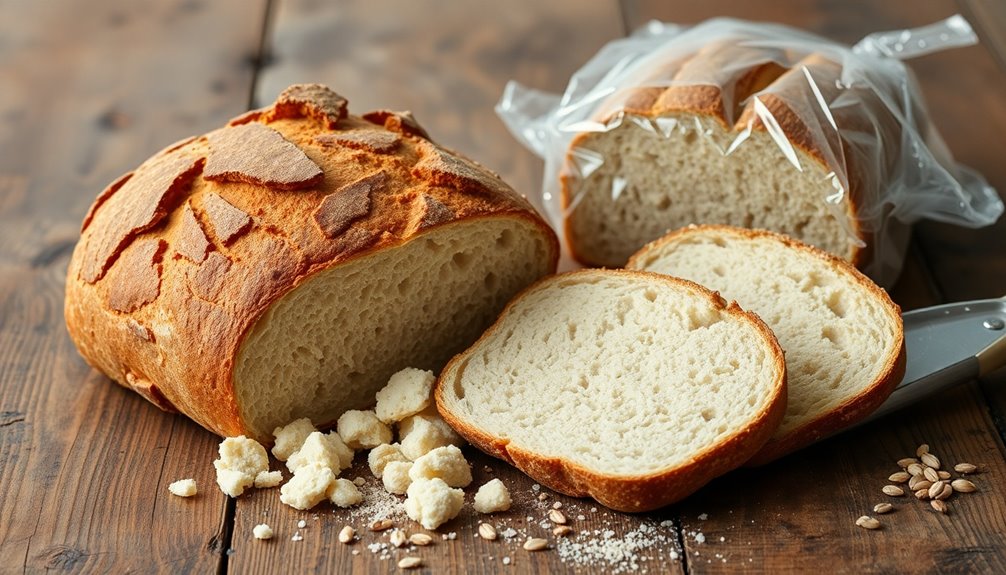
When you embrace the art of sourdough baking, you're tapping into the benefits of natural fermentation that enhance flavor and digestibility.
With just flour, water, and salt, the magic lies in the time and techniques you use to nurture your dough.
Let's explore how mastering these essential elements can transform your baking experience.
Natural Fermentation Benefits
Natural fermentation in sourdough baking reveals a world of flavors and health benefits that store-bought bread often lacks.
When you embrace the art of making homemade bread, you'll discover how natural fermentation transforms simple ingredients into a nourishing staple.
Here are some key benefits of sourdough fermentation:
- Enhanced Flavor: The wild yeast and bacteria create complex flavors that elevate your bread.
- Improved Digestibility: Fermentation breaks down gluten and phytic acid, making sourdough easier on your stomach.
- Lower Glycemic Index: This means better blood sugar management compared to conventional breads.
- Gut Health Support: The lactic acid bacteria in sourdough promote a balanced microbiome, aiding nutrient absorption.
- No Additives: With just flour, water, and salt, you avoid the preservatives often found in store-bought options.
Essential Sourdough Ingredients
Making sourdough bread is an art that hinges on a few key ingredients, each playing an essential role in the final product. The backbone of your sourdough is the sourdough starter, a mixture of flour and water that captures wild yeast and beneficial bacteria. This starter requires regular feeding with equal parts flour and water to stay active and potent, ensuring a successful fermentation process.
The type of flour you choose can greatly impact your bread's flavor and texture. Whole grain flours, like whole wheat or rye, enhance the nutritional content and create a denser loaf compared to all-purpose flour.
These flours also contribute to the development of unique flavors during the fermentation process, which typically takes 12 to 24 hours. This long fermentation time not only imparts a tangy flavor but also helps break down gluten and phytic acid, improving digestibility and nutrient absorption.
With the right ingredients and a little patience, you'll create a delicious loaf that's healthier than conventional bread, showcasing the beauty of sourdough baking. Embrace the process, and enjoy the rewards of your homemade creation!
Baking Techniques Explained
The art of sourdough baking relies heavily on mastering specific techniques that transform simple ingredients into a delicious loaf. You'll need to focus on proper fermentation, which utilizes wild yeast and beneficial bacteria to enhance flavor and improve digestibility.
Here are some essential baking techniques to reflect upon:
- Kneading: Develops gluten structure, giving your bread the desired texture.
- Shaping: Properly shapes the dough to create a uniform loaf.
- Proofing: Allows the dough to rise, increasing volume and flavor.
- Scoring: Cuts the surface to control the bread's expansion during baking.
- Baking: Creates the crust and final texture through the right temperature and time.
As you practice these techniques, remember that patience is key.
The fermentation process in sourdough not only breaks down gluten and phytic acid, making nutrients more bioavailable but also supports gut health. Community resources can help you get started with starter cultures and guidance.
With time and practice, you'll create homemade bread that rivals any store-bought option, enriched by the love and skill you put into each loaf.
Impact on Blood Sugar Levels
Homemade bread's potential to stabilize blood sugar levels offers a significant advantage over many store-bought options. When you bake at home, you can choose lower glycemic index flours, which help maintain metabolic health. In contrast, many commercial breads contain refined sugars that can cause your blood sugar levels to spike.
Sourdough bread, in particular, is beneficial due to its natural fermentation process. This method enhances carbohydrate digestibility and lowers the overall glycemic index, providing a more favorable impact on blood sugar levels. With homemade bread, you have full control over the sugar content, allowing you to create healthier alternatives that better suit your dietary needs.
Moreover, the longer fermentation in homemade bread, especially sourdough, breaks down gluten and phytic acid, which improves digestibility and nutrient absorption. This further supports stable blood sugar levels.
However, even with healthier homemade options, moderation is key. Overindulging can still lead to digestive issues and affect your blood sugar if not balanced with other dietary elements. So, while homemade bread is a smart choice, be mindful of portion sizes to truly reap the benefits.
Common Additives in Store-Bought Bread
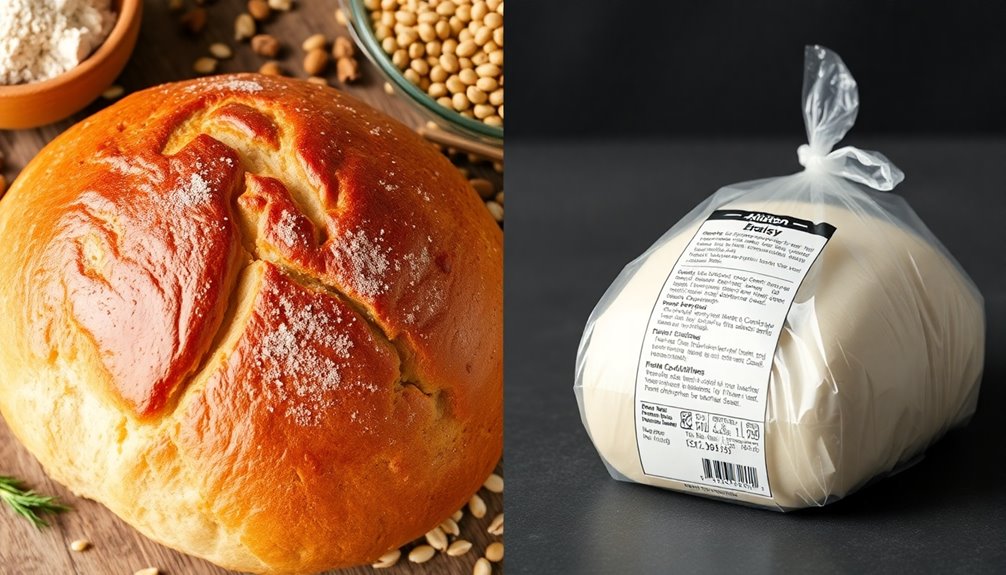
When you grab a loaf of store-bought bread, you mightn't realize the hidden sugars and preservatives lurking inside.
Ingredients like high fructose corn syrup can sneak into your diet, impacting your health more than you think.
Let's take a closer look at these common additives and what they mean for your bread choices.
Common Preservatives Found
In the domain of convenience, store-bought bread often contains a range of preservatives designed to extend shelf life and enhance flavor.
While these common preservatives may keep your bread fresh longer, they can come with potential health risks.
Here are some typical preservatives you might find:
- Calcium propionate: Inhibits mold growth but may cause digestive issues.
- High fructose corn syrup: Added for sweetness and shelf life, it can lead to weight gain and health concerns.
- Potassium bromate: Strengthens dough but is linked to possible carcinogenic effects and is banned in several countries.
- Mono- and diglycerides: Used for texture and freshness, they may contain trans fats that negatively affect heart health.
- Artificial flavors and colors: Enhance taste and appearance but offer no nutritional benefit and may trigger allergic reactions.
Understanding what's in your store-bought bread can help you make healthier choices.
While convenience is tempting, weighing the benefits against these common preservatives is essential for your well-being.
Hidden Sugars Analysis
Many store-bought breads sneak in hidden sugars, often disguised under various names like high fructose corn syrup or cane sugar. You might be surprised to find that a typical slice can contain 1-3 grams of added sugar, with some brands packing up to 5 grams per slice.
These hidden sugars not only add unnecessary calories but can also negatively impact your health. Regular consumption of these added sugars may lead to weight gain, increased blood sugar levels, and a higher risk of developing diabetes and heart disease.
When you choose homemade bread, you have complete control over the sugar content, allowing you to reduce or eliminate added sugars altogether. This choice promotes healthier eating habits and guarantees you're aware of what goes into your food.
It's essential to read ingredient labels carefully. Some brands may use misleading marketing terms like "whole grain" while still hiding high amounts of hidden sugars.
Environmental Benefits of Homemade Bread
Homemade bread offers significant environmental advantages over its store-bought counterpart. When you choose to bake at home, you're not just enjoying fresh bread; you're also making a positive impact on the environment. Here's how:
- Less Packaging Waste: Homemade bread means you avoid the plastic wrappers and boxes that contribute to environmental pollution.
- Local Ingredients: By sourcing your flour and grains locally, you support sustainable agricultural practices and reduce the carbon footprint linked to transporting processed bread.
- Quality Control: You can select organic and non-GMO grains, which promote environmentally friendly farming methods that enhance soil health and biodiversity.
- Mindful Consumption: Baking only what you need minimizes food waste. You can freeze any surplus, while store-bought bread often leads to excess that may spoil.
- Energy Efficiency: Using energy-efficient methods, like a Dutch oven, can help you consume less energy compared to the industrial processes used for mass-producing store-bought bread.
Conclusion
When you weigh the incredible health benefits, cost savings, and ingredient control of homemade bread against store-bought options, it's like comparing a majestic mountain to a mere molehill! You'll not only dodge a barrage of additives but also enjoy the blissful satisfaction of crafting your own loaf. So, why settle for the bland, preservative-laden slices from the store when you can create a masterpiece that's healthier, tastier, and downright magical? Your taste buds—and wallet—will thank you!

